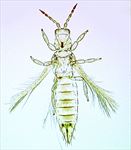
Female
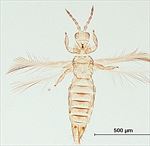
Female

Antenna
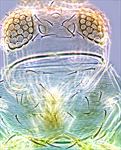
Head & pronotum
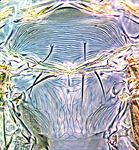
Meso & metanotum

Tergites V–VIII
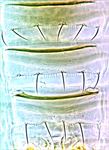
Sternites V–VII

Fore wing

Male hind leg
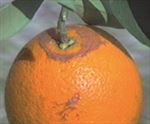
Feeding damage on orange
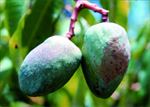
Feeding damage on mango

Feeding damage on mango leaf

Feeding damage to Mother of Millions
Distinguishing features
Female macroptera. Body yellow with brown markings medially on tergites and sternites, antecostal ridges on tergites and sternites dark brown; fore wings weakly shaded, paler toward apex; antennal segment I pale, II dark, III–IV pale with apex shaded, V–VIII dark. Head about twice as wide as long, postocular and ocellar region closely striate; ocellar setae pair III arise within ocellar triangle on or close to tangent between anterior margins of posterior ocelli, distance between their bases less than diameter of first ocellus; compound eyes with no ommatidia strongly pigmented; two pairs of post-ocellar setae longer than ocellar setae pair III. Pronotum closely striate, posteromarginal setae S2 clearly longer than S1. Metanotal sculpture variable, transverse anteriorly, longitudinally reticulate posteriorly; median pair of setae at anterior margin. Fore wing clavus with 3–4 marginal setae; second vein with 2 – 5 setae; posteromarginal fringe cilia all weakly undulating. Tergites III–V with bases of median setae usually closer together than length of these setae; tergal microtrichial fields with 3 discal setae; VIII with discal microtrichia present anteromedially, posteromarginal comb complete; tergite IX with discal microtrichia absent. Sternites almost covered with microtrichia except anteromedially on VII.
Male macroptera. Similar to female in colour and sculpture, but smaller; hind femur with row of 5–7 stout dark setae on distal posterior margin; aedeagus apparently with no armature.
Related species
The genus Scirtothrips comprises over 100 described species worldwide, with 21 species known from Australia most of which are endemics to this continent. These species all have the lateral thirds of the abdominal tergites covered in closely spaced rows of fine microtrichia, and in many species the sternites also bear similar microtrichia. The antennae are 8-segmented, except in S. casuarinae and S. solus, both forewing veins have an irregular and incomplete setal row, and a median spinula is present on both the meso and metafurca. Only one other species of Scirtothrips in Australia has microtrichial fields extending fully across the sternites; in S. aurantii, these almost cover the entire surface, whereas in S. dorsalis they are restricted to the posterior half of each sternite. The fore wing posteromarginal cilia are wavy in S. aurantii but straight in S. dorsalis, and moreover S. aurantii is unique within this genus in having a comb of stout dark setae on the posterior margin of the hind femora of males.
Biological data
Feeding and breeding on young leaves and fruits, with adults recorded from approximately 30 different plant families. In Australia, commonly restricted to Mother of Millions, Bryophyllum and Kalanchoe (Crassulaceae), but a potential pest of several crops including Mango and Blueberry (Garms et al., 2013)
Distribution data
Widespread in Africa; introduced to Australia and recorded from Queensland and northern New South Wales.
Family name
THRIPIDAE - THRIPINAE
Species name
Scirtothrips aurantii Faure
Original name and synonyms
Scirtothrips aurantii Faure, 1929: 3
Scirtothrips acaciae Moulton, 1930: 200
References
Garms BJ, Mound LA & Schellhorn NA (2013) Polyphagy in the Australian population of South African citrus thrips (Scirtothrips aurantii Faure). Australian Journal of Entomology 52: 282–289.
Hoddle MS & Mound LA (2003) The genus Scirtothrips in Australia (Insecta, Thysanoptera, Thripidae). Zootaxa 268: 1–40. http://www.mapress.com/zootaxa/2003f/zt00268.pdf